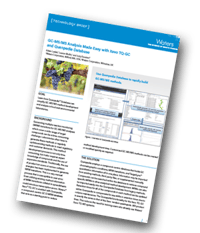
Separation Science, in collaboration with Waters, offers a selection of tutorials and resources to help simplify GC-MS/MS method development in food and environmental laboratories using the Xevo TQ-GC.
View the presentations from the two experts below and download the resources to see how improvements can be made in your laboratory.
 |
The Perfect Addition To Your Laboratory - Introducing a new EI GC-MS/MS system
presented by Adam Ladak (Senior Strategic Scientific Marketing Manager, Food and Environment Business Operations, Waters Corporation, Milford MA, USA)
Pesticide residues remain high on the list of consumer concerns around food safety and as a consequence laboratories are required to screen samples for as many pesticides as possible in a single analysis, within a suitable timescale. The majority of countries have clearly defined regulations governing pesticide residues, with legislation imposing Maximum Residue Limits (MRLs) for pesticide residues in food commodities, requiring analytical techniques that are sensitive, accurate, and robust.
In this presentation Adam Ladak introduces the new Xevo TQ-GC, GC-MS/MS system and describes a sensitive, multi-class method for the routine determination of pesticide residues in QuEChERS extracts of various fruit and vegetables.

|
 |
Xevo TQ-GC Mass Spectrometry System
presented by Tim Jenkins (Director - Global Market Development, Waters)
This presentation introduces the Xevo TQ-GC mass spectrometry system that provides a robust EI and CI GC-MS/MS platform engineered to maximize uptime with minimal method development enabled by Quanpedia™ method database driven workflows. It offers high performance and is reliable so you can easily surpass regulatory limits and features rapid and mistake-proof source design to simplify maintenance tasks.Furthermore, it can reduce training time and costs with a single software workflow for LC-MS/MS and GC-MS/MS analysis

|
RESOURCES
GC-MS/MS Pesticide Analysis in Green Tea using Targeted MRM and Full Scan Analysis in a Single Acquisition
This poster demonstrates an easy method setup for targeted analysis of pesticides in green tea. The Xevo TQ-GC has simplified workflows that enable users to produce results that meet regulatory recommendations. The added functionality of RADAR allows full scan and MRM data to be collected simultaneously. This data can be interrogated to identify change to understand extraction interferences at the time of the original analysis, or as part of a retrospective data mining investigation. The combination of MRM and full scan in a single method acquisition does not impact sensitivity and is valuable for use in method optimization.

 |
GC-MS/MS Analysis Made Easy with Xevo TQ-GC and Quanpedia Database
In this technology brief, learn how Quanpedia™ Database can simplify GC-MS/MS method development and analysis in food and environmental laboratories. The Xevo TQ-GC is equipped with Quanpedia, a compound-centric GC EI MRM database that acts as a starting point to reduce method development time. Customized GC-MS/MS methods can be created or modified quickly as required.

Improve Product Ion Confirmation Scanning with Xevo TQ-GC
In order to meet the requirements for identification of pesticide residues, at least two MRM transitions are monitored and their ion ratios and retention times must match that of the reference for the compound of interest. In this technology brief, learn how the Xevo TQ-GC can perform MRM analysis, as well as a product ion confirmation scanning (PICS) in a single acquisition, providing added confidence in your results.

Xevo TQ-GC: Run Extended Sample Sets Without User Intervention
This Technology Brief describes how the Xevo™ TQ-GC can produce consistent results in sample extracts, without the need for intervention by the user. It is shown that the operation of the system is efficient with a low frequency of down time for GC-related maintenance. By minimizing user intervention and delivering reliable results for extensive time periods, sample batch size can be increased maximizing laboratory throughput.

in collaboration with
